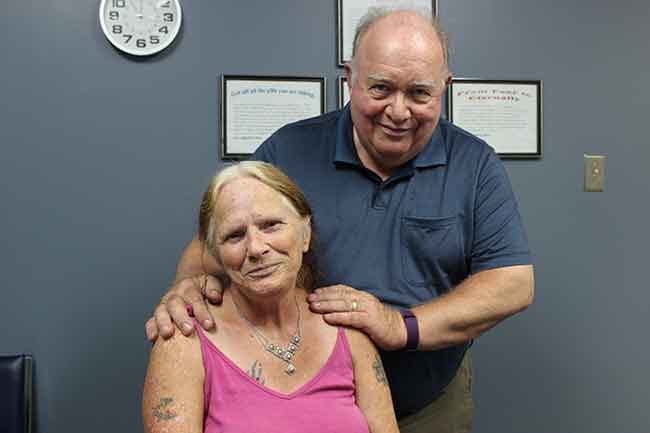
Pilots for change
Mari-Len De
Features Collaboration ProfessionCharting the course for publicly funded low-back pain care program
 Dr. Bruce Flynn with patient Brenda Miller (sitting), who hopes the low-back pain program of the Ontario government will continue beyond the pilot phase.
Dr. Bruce Flynn with patient Brenda Miller (sitting), who hopes the low-back pain program of the Ontario government will continue beyond the pilot phase. Brenda Miller had been suffering from debilitating back and leg pain since her vehicular accident in 2005. She was having difficulty walking and was constantly taking a cocktail of pain medications – Baclofen, Naproxen, Cymbalta, Pregabalin, Percocet, even Marijuana – just to help her manage through the day. Her condition has significantly affected her mobility that she had to quit her job and go on the Ontario Disability Support Program.
She was running out of options – until her doctor at Belleville Quinte West Community Health Centre told her about a government pilot project that is helping treat and manage people’s low back pain problems.
“This was my last hope; otherwise, they were going to cut the veins off my leg,” Miller recalls. Following a referral from her doctor, Miller was enrolled in the Ontario government’s Primary Care Low Back Pain (PCLBP) pilot program at the Belleville Nurse Practitioner-led Clinic in Belleville, Ont., where she met Dr. Bruce Flynn, a chiropractor with 44 years of clinical experience under his belt.
Miller started seeing Flynn three months ago. Today, Miller arrives at her regular chiropractic appointments with a big smile on her face and hardly any hint of mobility issue or severe pain that has plagued her for the last decade. She is also now able to do regular walks for at least an hour a day.
“I can’t believe it. When I first got here I couldn’t even walk to get here. But now, I can just boogie,” Miller laughs. “I’m getting my life back.”
The difference in Miller’s condition from when she started with the program to where she is now has been “day and night,” says Flynn, who left his private practice over a year ago to join the Belleville Nurse Practitioner-led Clinic and help implement the pilot project.
“When (Miller) came in she was constantly fidgeting and jumping because she had pain,” Flynn recalls. “She now has basically no pain… When she came in she had a frown on her face – almost to a point of depression by appearance. And now she’s happy, smiling, and very, very excited to see how much better she can get.”
Miller is only one of more than 1,900 Ontarians with low-back pain problems who have received care under the PCLBP pilot project. In the fall of 2014, the Ministry of Health announced seven primary care centres across Ontario as the pilot sites, consisting of family health teams, community health centres, nurse practitioner-led clinics and aboriginal health access centres.
Implementation of the pilot program began in January 2015. It provided funding for an interprofessional approach to patient care for the treatment and management of low back pain. The pilot projects were funded for a minimum of 12 months up to a maximum of 24 months.
All the pilot sites have a common mandate, according to the Ministry of Health: deliver a low back pain program through a range of primary care settings that integrate allied health providers into an interprofessional team that provides low back pain services, including treatment, assessment, education and referral.
At the Belleville pilot site, there are 175 patients enrolled in the PCLBP pilot with provincial funding up to September 2016. Flynn hopes the program will continue to be funded beyond that date.
“One of the main reasons for extending the program is because the results we’ve had have just been phenomenal,” says Flynn, who is at the Belleville Nurse Practitioner-led Clinic five days a week.
The Ontario Chiropractic Association (OCA) is working on precisely that same goal of extending the pilot project, and even potentially instituting a more sustainable, long-term and broader musculoskeletal health care program.
As an advocate for the chiropractic profession, the OCA has been working with the Ministry of Health in various initiatives that aim to bring chiropractic expertise to the forefront of primary care.
“Right now, the ministry funds a diabetes program within an interprofessional team, even (engages in) healthy aging health promotion, but there isn’t a targeted program for MSK,” says Marg Harrington, manager of health policy at the OCA.
All hands on deck
Patient satisfaction and better pain treatment and management are not the only reasons proponents are hailing the pilot project a success. Health practitioners at the pilot sites are equally excited about the enhanced delivery of care enabled by a team-based environment.
The PCLPB pilot essentially became the poster child for interprofessional health care collaboration.
“What it really allowed for was better patient management,” says Dr. Murray Townsend, chiropractor from Mount Forest, Ont. He is part of a network of health-care practitioners – including several other chiropractors, family physician, physiotherapists, kinesiologist, occupational therapist and clinical pharmacists – that form part of the Mount Forest PCLBP pilot site.
The coordinated approach to patient care also allowed for more efficient use of diagnostic imaging and better management of pain medications, he adds.
Interprofessional collaboration also paved the way for more comprehensive patient management that goes beyond just their low-back pain condition. “The other comorbidities were being managed a little bit better overall. We could refer into some of those. So if I had a patient whom I suspect wasn’t controlling their diabetes well, it wasn’t part of our program but the referral was happening quickly,” Townsend explains.
The same is true at the Belleville Nurse Practitioner-led Clinic, where “hallway” consultations about a patient has become a norm between Flynn and the other nurse practitioners at the clinic.
Before Flynn came onboard, the nurse practitioners had little opportunity for a multidisciplinary approach to low back pain management.
“From the program we got to understand (Flynn’s) role as a chiropractor and the interprofessional relationship to provide care for the patient has improved,” says Karen Clayton-Babb, chief nurse practitioner and clinic director at the Belleville Nurse Practitioner-led Clinic.
She acknowledges the addition of a chiropractor in the roster of providers at the clinic “enhanced our practice somewhat.” Even patients have reduced the frequency of follow up visits after being enrolled in the PCLBP pilot, she adds.
Clayton-Babb explains, “We understand (the chiropractor’s) role more. With the service here, (Flynn) has not only focused on his low back pain treatment, but he has also understood the role that immobility has on chronic disease. So he tends to communicate with us a lot.
“If we haven’t seen the patient and he’s seen the patient, there are things that he can pick up on and then have that discussion with us, so we have that interprofessional care going for the patients.”
Even the patients are noticing the difference in the care they receive when their health-care practitioners are operating on the same page.
Lisa Morris has been coming to the Belleville clinic for five years. Her sciatica has been worsening to the point that she is unable to sleep at night. During one of her appointments with the nurse practitioner, she saw the sign about the pilot program and asked to be signed up.
The first time she met with Flynn, she found the chiropractor asked “a hundred and one questions.”
“This has been the first time, in any time that I’ve ever been to any sort of doctor or professional, that they have actually spent time asking lots and lots of questions, and actually thinking that things were connected to something, instead of it being an isolated case,” Morris recalls. She sees how her nurse practitioner and chiropractor are working together to care for her as a patient.
“Because (Flynn) is in contact with my nurse (practitioner) whom I see on a regular basis… they’re looking at me as a whole piece, not just fixing (a part of me). They’re trying to see what they can do to help me be better as a whole.”
It’s been a year since she signed up for the PCLBP program, and Morris is now moving better and sleeping better. She says it’s been months since she has taken her usual over-the-counter pain medications. She also learned how to “listen” to her body a little better and implement some home care regimen.
As a self-employed artist, she depends on her physical wellbeing and functional mobility to perform her tasks. She admits she might never be able to totally get rid of her pain (she also has arthritis), but the level of pain she has now is manageable and does not prevent her from living her life and doing her work.
“This has enabled me to work, rather than curling up and feeling defeated,” she says triumphantly. “I’d rather not go on disability because I don’t have a pension plan.”
Outcomes
The pilot sites report back to the Ministry of Health and Long-Term Care about program implementation and patient outcomes and progress.
“All seven pilot sites have met expectations regarding integration of low back pain care into primary care setting,” the ministry says in an e-mail to Canadian Chiropractor. “Patient enrolment is consistent with project expectations and patients are demonstrating satisfaction with their service.”
Since the launch of the pilot project, the ministry has received “positive feedback” from the pilot sites and reports more than 50 per cent of patients served have indicated “feeling satisfied with their LBP services (e.g. consult, examination, care services) and have indicated an improvement in self-management techniques after participating in the program.”
The ministry adds it will continue to assess progress of the project and is working toward enhancing the evaluation process by adding a “qualitative component”.
The World Health Organization cites low-back pain as a leading cause of disability worldwide. Up to 80 per cent of the population will experience low back pain at least once in their lifetime.
Low back pain costs the health care system between $6 billion and $12 billion annually, according to Bone and Joint Canada. The costs are even greater if one factors in losses in worker productivity and associated disability payments.
Sixteen DCs were involved in six of the seven pilot sites for the PCLBP program. The OCA interviewed many of the chiropractors from the pilot sites to gauge their experiences.
“The chiropractors felt that the care was more comprehensive and effective because it was a team-based model,” says Harrington from the OCA. “It also provided an opportunity to learn about the contribution that other team members could make.”
Through the pilot projects, chiropractors are able to demonstrate the need for a comprehensive MSK programming within the public health care system that incorporates a variety of health practitioners, including chiropractors.
The OCA sees the pilot project as a “great opportunity” for the profession.
“We are trying to maximize the exposure it gets, and we do see multiple goals,” Harrington notes. “One being enhancement of the role, an opportunity for chiropractors within teams, but also increased awareness about the value that chiropractic and MSK programming, in general, can provide to Ontarians.”
As much as the project has been an opportunity to demonstrate the role that chiropractors can play in low back pain management, it has also been a learning experience for the chiropractors who were involved in the project. Interprofessional collaboration and patient-centred care have been the battle cry in recent years in the quest for a better approach to health care. The pilot project gave health-care professionals the opportunity to work in that regime first hand.
The experience certainly made an impact on Townsend, one of the chiropractors involved in the Mount Forest pilot site.
“I’ve practiced for several years without this coordinated effort with other practitioners. And the thought 20 years ago (when I graduated) of me working with a physiotherapist and the doctors and nurse practitioners, I would have told someone there’s just no way that was ever happening.
“But now, it’s not just that it happened, but how well we could work together and how happy patients were. This is what they’ve been wanting to see all along. It’s just better outcomes, pure and simple.”
The health ministry recognizes these positive outcomes, as it continues to work with the pilot sites, clinician leaders and other stakeholders. So far, the province appears to recognize the need for institutionalizing a more sustainable model of care for low back pain management. A clinical handbook for non-emergent integrated spine care has been developed and is currently being reviewed for potential implementation.
Patient feedback
Dr. Bruce Flynn’s office wall at the Belleville Nurse Practitioner-led Clinic is full of framed letters from patients who benefitted from the low back pain pilot project. Here are excerpts from those patient letters.
“I was taking Tylenol for back pain (3 per day, $21.99 per box), Tylenol Muscle Aches and Body Pain (3 per day, $15.99 per box), Tylenol Body Pain Night (3 per day, $16.99 per box), Tylenol Ultra Relief (2 per day) and sometimes Tylenol Extra Strength ($20 per box). I would get up in the morning and still have pain in my back. Since coming to the chiropractor I now take no pills and put $40 per month in my bank account. I also walk to church and back (one hour each way), and this past weekend I walked to Quinte Mall from Moira Street West and back again (one hour each way) and still have no pain. You can do it too.” – A.S., August 4, 2015
“I was under the impression that my aches and pains were a result of multiple injuries I had suffered over the course of my life. I was also under the impression that pain was permanent. I had experienced severe pain as I was growing up at the hands of other people and had come to accept that as part of life. I believed that, one, I could not afford to see a chiropractor, and two, it would not help. I probably needed surgery that would leave me crippled (drama, I know). I was blown away by the pilot project for this to be covered under OHIP. I am so very happy and amazed that I sleep through the night and do not wake up with excruciating pain. I have been more connected to my body and adjusting the way I move a bit better or sit when I need to. It has made me more aware that I need to do this regularly to stay in a better place.” – L.M., October 27, 2015
“I would like to take this opportunity to thank you for helping me with the back pain I have suffered with for over eleven years. I believed I would be stuck with this pain for the rest of my life after my accident. I was taking 6 Percocet per day, along with 6 Tylenol #3 and using marijuana to cope with the pain. After only a few adjustments I started to feel so much better. Now that I have had several more treatments I am walking and standing taller. I have eliminated the Percocet and Tylenol #3 and now have no pain. I want to thank everyone in your clinic, as you are all amazing people. I have recommended you to several of my friends. I am so grateful to you all for helping me.” – B.M., June 6, 2016
Mari-Len De Guzman is the editor of Canadian Chiropractor magazine. She has been a journalist for 20 years and has been editor of several business and professional publications. You can contact her at mdeguzman@annexweb.com.
Print this page

